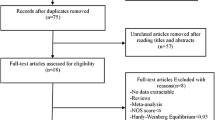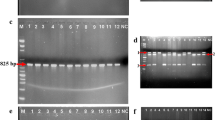Abstract
The study was conducted to investigate the relationship between vitamin D receptor (VDR) gene rs2228570 and rs1544410 polymorphisms and pancreatic cancer (PC). Two hundred fifty-eight PC patients and 385 healthy controls were enrolled in this study. The genotypes of rs2228570 and rs1544410 were assayed using the polymerase chain reaction/restriction fragment length polymorphism (PCR-RFLP) method. Univariate and multivariate logistic regression analyses were applied to determine the association between PC-onset risk and VDR gene polymorphisms. Contingency table analysis was performed to evaluate the relationship between the gene polymorphisms and clinicopathological tumor features such as location, pathological differentiation, and the TNM classification of PC. In rs2228570, the T loci and genotypes with T allele could increase the risk of PC; in rs1544410, the G loci and genotypes AG + GG could decrease the onset risk of PC significantly. The contingency table analysis indicated that the rs2228570 polymorphisms were correlated with the pathological differentiation of PC significantly, and the rs1544410 polymorphisms were correlated with the TNM classification of PC significantly. In conclusion, the VDR gene polymorphisms were correlated with incidence, pathological differentiation, and the TNM classification of PC significantly in our study population. So, the VDR polymorphisms have important implications in the incident rate and survival rate of PC.



Similar content being viewed by others
References
Jemal A, Bray F, Center MM, et al. Global cancer statistics. CA Cancer J Clin. 2011;61:69–90.
Wolfgang CL, Herman JM, Laheru DA, et al. Recent progress in pancreatic cancer. CA Cancer J Clin. 2013;63:318–48.
Greer JB, Brand RE. New developments in pancreatic cancer. Curr Gastroenterol Rep. 2011;13:131–9.
Yadav D, Lowenfels AB. The epidemiology of pancreatitis and pancreatic cancer. Gastroenterology. 2013;144:1252–61.
Iodice S, Gandini S, Maisonneuve P, Lowenfels AB. Tobacco and the risk of pancreatic cancer: a review and meta-analysis. Langenbecks Arch Surg. 2008;393:535–45.
Haas SL, Ye W, Lohr JM. Alcohol consumption and digestive tract cancer. Curr Opin Clin Nutr Metab Care. 2012;15:457–67.
Norell SE, Ahlbom A, Erwald R, et al. Diet and pancreatic cancer: a case-control study. Am J Epidemiol. 1986;124:894–902.
Duell EJ, Lucenteforte E, Olson SH, et al. Pancreatitis and pancreatic cancer risk: a pooled analysis in the International Pancreatic Cancer Case-Control Consortium (PanC4). Ann Oncol. 2012;23:2964–70.
Zhu F, Li HR, Du GN, et al. Chronic hepatitis B virus infection and pancreatic cancer: a case-control study in southern China. Asian Pac J Cancer Prev. 2011;12:1405–8.
Li L, Wu B, Yang LB, et al. Chronic hepatitis B virus infection and risk of pancreatic cancer: a meta-analysis. Asian Pac J Cancer Prev. 2013;14(1):275–9.
Chiang KC, Yeh CN, Hsu JT, et al. MART-10, a novel vitamin D analog, inhibits head and neck squamous carcinoma cells growth through cell cycle arrest at G0/G1 with upregulation of p21 and p27 and downregulation of telomerase. J Steroid Biochem Mol Biol. 2013;138:427–34.
Jehan F, d’Alesio A, Garabedian M. Exons and functional regions of the human vitamin D receptor gene around and within the main 1a promoter are well conserved among mammals. J Steroid Biochem Mol Biol. 2007;103(3–5):361–7.
Miyamoto K, Kesterson RA, Yamamoto H, et al. Structural organization of the human vitamin D receptor chromosomal gene and its promoter. Mol Endocrinol. 1997;11(8):1165–79.
Harries LW, Stubbins MJ, Forman D, et al. Identification of genetic polymorphisms at the glutathione S-transferase Pi locus and association with susceptibility to bladder, testicular and prostate cancer. Carcinogenesis. 1997;18(4):641–4.
Arjumand W, Ahmad ST, Seth A, et al. Vitamin D receptor FokI and BsmI gene polymorphism and its association with grade and stage of renal cell carcinoma in North Indian population. Tumour Biol : J Int Soc Oncodevelopmental Biol Med. 2012;33(1):23–31.
Siegel R, Ma J, Zou Z, et al. Cancer statistics, 2014. CA Cancer J Clin. 2014;64(1):9–29.
Malvezzi M, Bertuccio P, Levi F, et al. European cancer mortality predictions for the year 2014. Ann Oncol. 2014;25(8):1650–6.
Laheru D, Biedrzycki B, Jaffee EM. Development of a cytokine-modified allogeneic whole cell pancreatic cancer vaccine. Methods Mol Biol. 2013;980:175–203.
Yadav D, Lowenfels AB. The epidemiology of pancreatitis and pancreatic cancer. Gastroenterology. 2013;144(6):1252–61.
Wagner M, Redaelli C, Lietz M, et al. Curative resection is the single most important factor determining outcome in patients with pancreatic adenocarcinoma. Br J Surg. 2004;91(5):586–94.
Poruk KE, Firpo MA, Mulvihill SJ. Screening for pancreatic cancer. Adv Surg. 2014;48:115–36.
Bournet B, Gayral M, Torrisani J, et al. Role of endoscopic ultrasound in the molecular diagnosis of pancreatic cancer. World J Gastroenterol. 2014;20(31):10758–68.
Wong HH, Lemoine NR. Pancreatic cancer: molecular pathogenesis and new therapeutic targets. Nat Rev Gastroenterol Hepatol. 2009;6(7):412–22.
Chou A, Waddell N, Cowley MJ, et al. Clinical and molecular characterization of HER2 amplified-pancreatic cancer. Genome Med. 2013;5(8):78.
Giangreco AA, Dambal S, Wagner D, et al. Differential expression and regulation of vitamin D hydroxylases and inflammatory genes in prostate stroma and epithelium by 1,25-dihydroxyvitamin D in men with prostate cancer and an in vitro model. J Steroid Biochem Mol Biol. 2014. (14)00237-4.
Gündüz M, Cacına C, Toptaş B, et al. Association of vitamin D receptor gene polymorphisms with colon cancer. Genet Test Mol Biomarkers. 2012;16(9):1058–61.
Vogt DP. Pancreatic cancer: a current overview. Curr Surg. 2000;57(3):214–20.
Van Loon K, Owzar K, Jiang C, et al. 25-Hydroxyvitamin D levels and survival in advanced pancreatic cancer: findings from CALGB 80303 (Alliance). J Natl Cancer Inst. 2014; 106(8).
Colston KW, James SY, Ofori-Kuragu EA, et al. Vitamin D receptors and anti-proliferative effects of vitamin D derivatives in human pancreatic carcinoma cells in vivo and in vitro. Br J Cancer. 1997;76(8):1017–20.
Verlinden L, Verstuyf A, Van Camp M, et al. Two novel 14-Epi-analogues of 1,25-dihydroxyvitamin D3 inhibit the growth of human breast cancer cells in vitro and in vivo. Cancer Res. 2000;60(10):2673–9.
Campbell MJ, Elstner E, Holden S, et al. Inhibition of proliferation of prostate cancer cells by a 19-nor-hexafluoride vitamin D3 analogue involves the induction of p21waf1, p27kip1 and E-cadherin. J Mol Endocrinol. 1997;19(1):15–27.
Jiang YJ, Teichert AE, Fong F, et al. 1alpha,25(OH)2-dihydroxyvitamin D3/VDR protects the skin from UVB-induced tumor formation by interacting with the beta-catenin pathway. J Steroid Biochem Mol Biol. 2013;136:229–32.
Rosli SN, Shintani T, Hayashido Y, et al. 1alpha,25OH2D3 down-regulates HBp17/FGFBP-1 expression via NF-kappaB pathway. J Steroid Biochem Mol Biol. 2013;136:98–101.
DeBerardinis AM, Banerjee U, Miller M, et al. Probing the structural requirements for vitamin D3 inhibition of the hedgehog signaling pathway. Bioorg Med Chem Lett. 2012;22(14):4859–63.
Wang W, Zhao CH, Zhang N, Wang J. Vitamin D analog EB1089 induces apoptosis in a subpopulation of SGC-7901 gastric cancer cells through a mitochondrial-dependent apoptotic pathway. Nutr Cancer. 2013;65(7):1067–75.
Sherman MH, Yu RT, Engle DD, et al. Vitamin D receptor-mediated stromal reprogramming suppresses pancreatitis and enhances pancreatic cancer therapy. Cell. 2014;159(1):80–93.
Zhou H, Xu C, Gu M. Vitamin D receptor (VDR) gene polymorphisms and Graves’ disease: a meta-analysis. Clin Endocrinol (Oxf). 2009;70(6):938–45.
Zhou TB, Jiang ZP, Zj L, et al. Association of vitamin D receptor gene polymorphism with the risk of systemic lupus erythematosus. J Recept Signal Transduct Res. 2014;22:1–7.
van Etten E, Verlinden L, Giulietti A, et al. The vitamin D receptor gene FokI polymorphism: functional impact on the immune system. Eur J Immunol. 2007;37(2):395–405.
Cross HS. Extrarenal vitamin D hydroxylase expression and activity in normal and malignant cells: modification of expression by epigenetic mechanisms and dietary substances. Nutr Rev. 2007;65(8 Pt 2):S108–12.
Ogunkolade BW, Boucher BJ, Prahl JM, et al. Vitamin D receptor (VDR) mRNA and VDR protein levels in relation to vitamin D status, insulin secretory capacity, and VDR genotype in Bangladeshi Asians. Diabetes. 2002;51(7):2294–300.
Jurutka PW, Whitfield GK, Hsieh JC, et al. Molecular nature of the vitamin D receptor and its role in regulation of gene expression. Rev Endocr Metab Disord. 2001;2(2):203–16.
Valdivielso JM, Fernandez E. Vitamin D receptor polymorphisms and diseases. Clin Chim Acta. 2006;371(1–2):1–12.
Li L, Wu B, Yang L, et al. Association of vitamin D receptor gene polymorphisms with pancreatic cancer: a pilot study in a North China population. Oncol Lett. 2013;5(5):1731–5.
Liu Y, Chen W, Hu ZB, et al. Plasma vitamin D levels and vitamin D receptor polymorphisms are associated with survival of non-small cell lung cancer. Chin J Cancer Res. 2011;23(1):33–7.
Raimondi S, Johansson H, Maisonneuve P, et al. Review and meta-analysis on vitamin D receptor polymorphisms and cancer risk. Carcinogenesis. 2009;30(7):1170–80.
Oh JJ, Byun SS, Lee SE, et al. Genetic variations in VDR associated with prostate cancer risk and progression in a Korean population. Gene. 2014;533(1):86–93.
Alimirah F, Peng X, Murillo G, et al. Functional significance of vitamin D receptor FokI polymorphism in human breast cancer cells. PLoS One. 2011;6(1):e16024.
Speer G. The role of vitamin D in the prevention and the additional therapy of cancers. Magy Onkol. 2010;54(4):303–14.
Conflicts of interest
None
Author information
Authors and Affiliations
Corresponding author
Rights and permissions
About this article
Cite this article
Li, L., Shang, F., Zhang, W. et al. Role of vitamin D receptor gene polymorphisms in pancreatic cancer: a case–control study in China. Tumor Biol. 36, 4707–4714 (2015). https://doi.org/10.1007/s13277-015-3119-6
Received:
Accepted:
Published:
Issue Date:
DOI: https://doi.org/10.1007/s13277-015-3119-6




